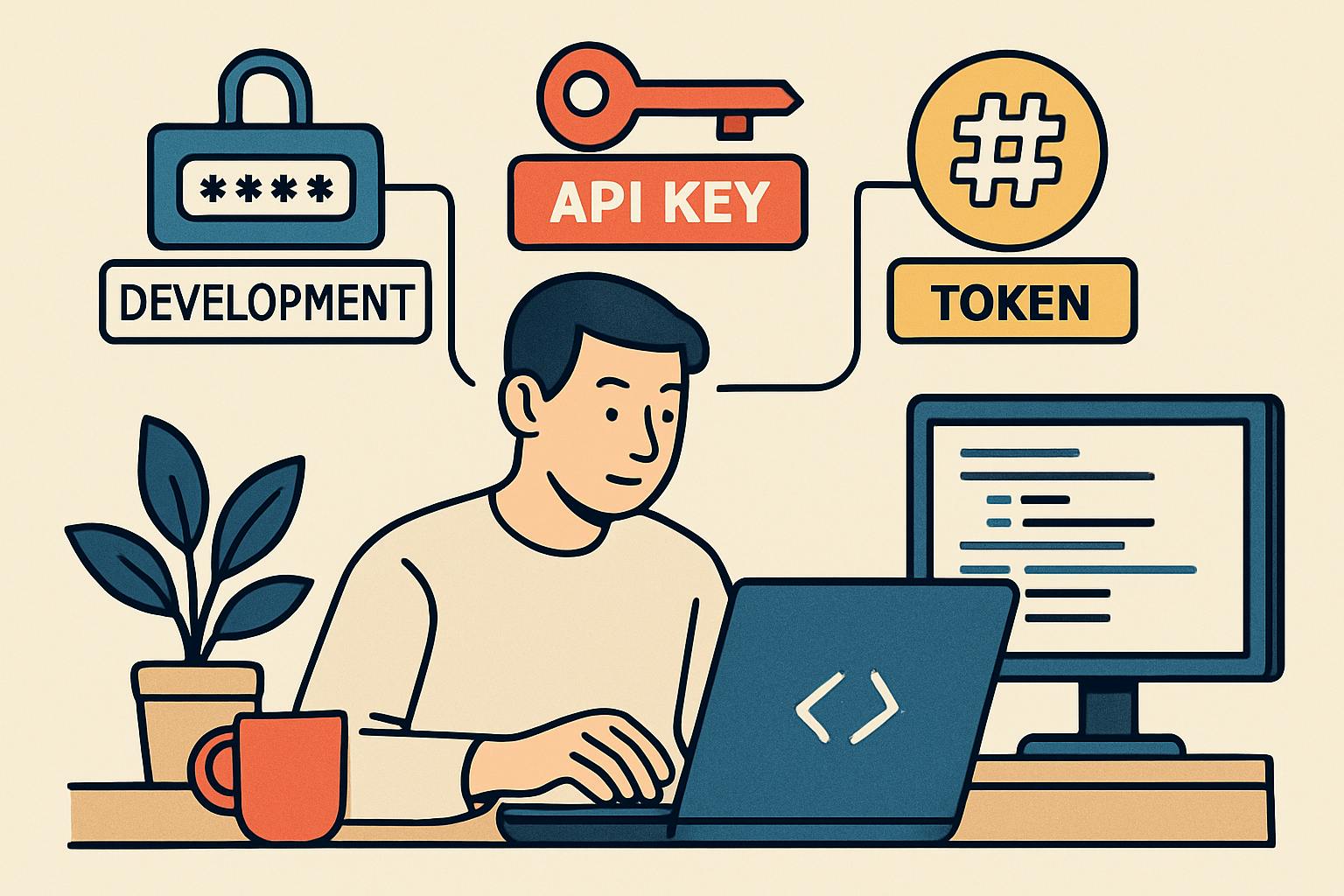Stop Exposed Secrets from Breaching Your Code Today: 4 Urgent Steps to Protect Your Organization
Urgent Steps to Stop Secret Exposure & Save Your Data
Picture this: You spot a hidden API key in your company’s source code. Panic sets in as you realize it could lead to unauthorized access, data leaks, and a ruined reputation. You know the risk, but without context, how do you act fast?
Secrets management is critical in today’s increasingly vulnerable digital landscape. According to the 2025 “State of Secrets Sprawl” report by GitGuardian, over 23 million new hardcoded secrets on GitHub in 2024, a staggering 25% increase from 2023.
Scanners identify exposed secrets like keys or tokens in code, but they typically lack essential context. Without proper context, your response becomes ineffective. Let’s address this by exploring practical strategies, real-world examples, and open-source tools to help you secure your secrets effectively. We’ll also include code examples to demonstrate how these tools work in practice.
Context Matters: 4 Factors to Address Exposed Secrets
You guard your secrets, so focus on what truly helps. Here’s how, with practical examples to illustrate each step.
1# Classify by Sensitivity
Not every secret is equal. A high-risk admin key demands quick action over a low-priv test one. Prioritize to save time and avoid panic.
Practical Example: Imagine a leaked AWS IAM access key with full administrative privileges. This is not just a minor issue but could allow attackers to spin up costly resources or delete entire databases, as seen in the 2017 Capital One breach where a misconfigured web app firewall led to the exposure of 100 million customer records. Classify it as “critical” and act immediately, whereas a read-only key for a non-production environment might be “low-risk” and scheduled for routine rotation.
2# Assess Scope and Impact
Is the secret in a public repo or internal? If public, it could spark breaches affecting thousands. Gauge the risk to build a smart plan.
Practical Example: A developer accidentally commits a database password to a public GitHub repository during a quick fix. If it’s for a production database holding sensitive customer data, the impact could be massive. Hackers might exfiltrate information, leading to regulatory fines under GDPR or HIPAA. Assess by checking access logs: Has the repo been forked or viewed unusually? This helps quantify the “blast radius” and prioritize containment.
3# Find the Root Cause
Why did it leak? Fix sloppy commits or weak reviews to stop repeats. This prevents future headaches and builds stronger security habits.
Practical Example: In many cases, root causes trace back to human error, like hardcoding secrets in code for convenience. For instance, a team rushing a deployment might skip code reviews, allowing a token to slip into a public branch. To fix this, implement pre-commit hooks and peer reviews. A real-world lesson comes from the 2023 SolarWinds supply chain attack, where compromised credentials amplified the breach. Addressing root causes like inadequate access controls could have mitigated it.
4# Enrich with Metadata
Secrets hold details like owners, creation dates, and access levels. Tools like Entro map these into a “secret lineage” view, showing app connections and risks clearly.
Practical Example: Consider a Stripe payment API key exposed in a codebase. By enriching it with metadata, you discover it’s owned by the finance team, created six months ago, and grants access to transaction data. This context reveals it’s linked to a high-value payment gateway, increasing urgency. Without metadata, you might overlook that rotating it requires coordinating with multiple teams to avoid downtime.
Act fast to limit damage. Rotate compromised keys, alert teams, and watch for odd activity. If severe, call experts or follow your incident response plan, which might include notifying authorities for compliance.
Prevent repeats with policies, training, and audits. For example, adopt a Zero Trust model where secrets are treated as always potentially exposed, using just-in-time access to minimize risks. Rotate secrets regularly every 90 days is a good benchmark via automated scripts in tools like AWS Secrets Manager.
Monitor continuously with automated tools for quick alerts. Integrate proactive scanning into your CI/CD pipelines (e.g., using GitHub Actions) to catch issues before they hit production. Train your team through workshops on secure coding practices, such as injecting secrets at runtime instead of hardcoding them.
Leverage Tech for Smarter Management
Automation speeds detection and fixes. Platforms like Entro discover owners, spot vault issues, and integrate with your tools for seamless security. But if you’re looking for cost-effective options, open-source alternatives can provide powerful capabilities without the enterprise price tag. Below, we’ll expand on more tools, including code examples to get you started.
- Scanning Tools: Use TruffleHog (github.com/trufflesecurity/trufflehog) for detecting secrets in Git repositories by scanning for high-entropy strings and known patterns. It’s great for historical scans of your codebase. Similarly, GitGuardian (github.com/GitGuardian/ggshield) integrates with CI/CD to prevent secrets from being committed in the first place. For pre-commit checks, try git-secrets (github.com/awslabs/git-secrets), which scans for AWS credentials and other patterns before commits.
Code Example with TruffleHog: Install via pip install trufflehog and scan a repo:
trufflehog git --since-commit HEAD~10
This scans the last 10 commits for potential secrets.
Code Example with git-secrets: Install and add patterns:
git secrets --install
git secrets --add 'AWS_ACCESS_KEY_ID'
git secrets --scan
- Encryption and Management: SOPS (github.com/mozilla/sops) allows you to encrypt secrets in Git, ensuring they’re stored securely and decrypted only in trusted environments. For a full self-hosted solution, try Infisical (github.com/Infisical/infisical), which manages secrets across teams with features like access controls and audit logs. Another robust option is HashiCorp Vault (github.com/hashicorp/vault), an open-source tool for storing, accessing, and rotating secrets securely with dynamic credentials.
Code Example with SOPS: Encrypt a YAML file using AWS KMS:
sops --encrypt --kms arn:aws:kms:us-east-1:123456789012:key/1234abcd-12ab-34cd-56ef-1234567890ab secrets.yaml > encrypted-secrets.yaml
To edit: sops encrypted-secrets.yaml.
Code Example with HashiCorp Vault: Start Vault in dev mode and store a secret:
vault server -dev
# (In another terminal)
export VAULT_ADDR=''
vault kv put secret/myapp db_password="s3cr3t"
vault kv get secret/myapp
- Mapping and Analysis: For environments like Active Directory, BloodHound (github.com/BloodHoundAD/BloodHound) helps map access graphs, revealing how exposed secrets could lead to lateral movement in attacks. To visualize secret-related risks in codebases, consider Yelp/detect-secrets (github.com/Yelp/detect-secrets), which baselines and scans for secrets with customizable rules.
Code Example with detect-secrets: Install via pip install detect-secrets and scan:
detect-secrets scan > .secrets.baseline
detect-secrets audit .secrets.baseline
These tools are community-driven and often free, with extensive documentation and integrations. For instance, combining TruffleHog with SOPS in your workflow can automate detection and encryption, reducing manual errors. Integrate them into Dockerfiles or Kubernetes manifests for cloud-native environments to ensure secrets are handled securely at scale.
Conclusion
Handling exposed secrets protects data and trust. With context, practical examples, and tools like the open-source ones mentioned, complete with code snippets, you can make smart fixes and cut risks dramatically. Remember, secrets management isn’t just about technology. It’s about building a culture of security. What’s your toughest secret challenge? Have you used any of these open-source tools or implemented similar code examples? Share below or on LinkedIn. Let’s discuss solutions together and learn from each other’s experiences.



